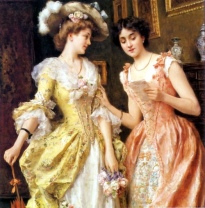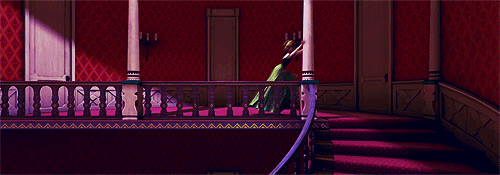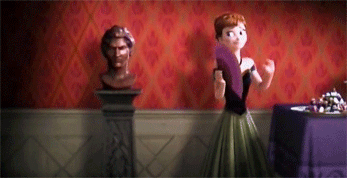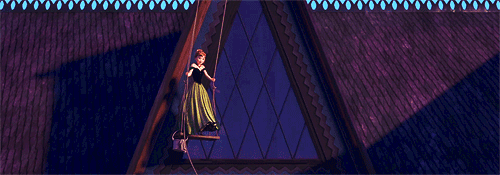This post contains spoilers about the film Frozen. Consider yourself warned.
1. Anna’s dress is Rococo:


Anna’s dress features a plunging neckline, an oriental-type
patterning, and several petticoats, all common features of rococo dress.
2. Anna is love:

From courtship, to flirting, to classical pagan deities, love is a pervasive theme in Rococo paintings. Frozen tells us several things about love. "Love can thaw a frozen heart" and "Love is putting someone else's needs before your own." Anna thaws Elsa's metaphorically frozen heart and her own literally frozen heart by putting Elsa's needs before her own, thus Anna perfectly conforms to the film's definition of love.
3. Anna is Spring:


Anna and Elsa are equal but opposite forces. Where Elsa is cold and distant, Anna is warm and bubbly. Where Elsa is winter, Anna is spring. Anna's primary color is green, symbolic of the new growth and new life we associate with spring. Due to love's association with spring, spring is frequently depicted in Rococo paintings.
4. Anna is joyous and frivolous:

From the way she moves, to her bubbly personality, to her love of parties, dancing, and fun, Anna reflects the joy and frivolity of the rococo.
5. This:

Yep, that's a Disney-fied version of the rococo painting "The Swing" by Fragonard... and that's Anna in front of it. Earlier, I mentioned that Anna's dress has several petticoats. Here we see at least two.
6. Anna is youthful:

Youth and young love are common subjects in the rococo. Throughout the film, we see both Anna and Elsa physically age, but while Elsa seems to be older than her years reflect, Anna maintains her youthful and energetic personality for the majority of the film.
7. Anna is playful:


You get a sense of this in all of Anna's songs, but especially in "Do You Want to Build A Snowman," which you can watch here: https://www.youtube.com/watch?v=ntRSopUllV4
8. And occasionally naughty:

Naughtiness, especially in Putti, is yet another theme of the Rococo. In the sequence of "For the First Time in Forever," Anna accidentally breaks an arm off of a suit of armor, sneaks chocolate before the party, and accidentally tosses a bust on top of the coronation cake. I think it's fair to say that she wasn't supposed to be doing any of these things.
You can watch "For the First Time in Forever" here: https://www.youtube.com/watch?v=ntRSopUllV4
9. Ana seeks to overthrow what she sees as the
overly-controlling policies of the monarchy:

Elsa, to keep her powers secret, has all but closed off the castle, but Anna can't handle being cooped up indefinitely. After a confrontation with Elsa, Anna says, "I can't do this anymore!" to which Elsa responds, "Then leave." Conflict arises because Anna doesn't want to leave her sister, but she also can't handle being closed off from the world. Her plan to marry seems to stem as much from her desire to find true love as her desire to end her isolation and loneliness. When the castle gates open for one day only, Coronation day, she seizes her chance.
10. Ana won’t let the monarchy decide who she
marries.

The Rococo marked a period of political freedom for the aristocracy. During the notoriously controlling reign of Louis XIV, the king decided who married whom. In the rococo, we see rejection of the control of the monarchy by aristocrats on personal matters like taste and whom to marry.
In Frozen, Anna does ask for the blessing of her sister on her marriage, but when Elsa responds, "You can't marry a man you just met," Anna won't take no for an answer. In the end, Anna breaks off the relationship, but it had nothing to do with the desires of the monarchy.
More about themes in Rococo:
1. Themes in Rococo paintings
2. The Rococo movement http://en.wikipedia.org/wiki/Rococo
3. Rococo dress http://historyofeuropeanfashion.wordpress.com/
No comments:
Post a Comment